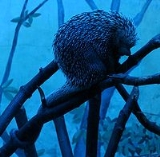
Prehensile-tailed porcupine
Encyclopedia
The prehensile-tailed porcupines or Coendous (genus Coendou) are a group of arboreal porcupine
found in Central
and South America
. They are closely related to the other Neotropical tree porcupines (genus Echinoprocta
and genus Sphiggurus
) and these three are sometimes treated as subgenera of Coendou instead of distinct genera.
tail. The front and hind feet are also modified for grasping. These limbs all contribute to making this animal an adept climber, an adaptation to living most of their lives in trees.
They feed on leave
s, shoots, fruit
s, bark
, roots, and buds. They can be pests of plantation
crops.
Young are born with soft hair that hardens to quills with age. Adults are slow-moving and will roll into a ball when threatened and on the ground. The record longevity
is 27 years (Gorbunova et al., 2008).
Woods and Kilpatrick (2005) argue that although members of the genus Sphiggurus
are sometimes included in Coendou, the two are distinct enough to warrant recognition of separate genera.
Porcupine
Porcupines are rodents with a coat of sharp spines, or quills, that defend or camouflage them from predators. They are indigenous to the Americas, southern Asia, and Africa. Porcupines are the third largest of the rodents, behind the capybara and the beaver. Most porcupines are about long, with...
found in Central
Central America
Central America is the central geographic region of the Americas. It is the southernmost, isthmian portion of the North American continent, which connects with South America on the southeast. When considered part of the unified continental model, it is considered a subcontinent...
and South America
South America
South America is a continent situated in the Western Hemisphere, mostly in the Southern Hemisphere, with a relatively small portion in the Northern Hemisphere. The continent is also considered a subcontinent of the Americas. It is bordered on the west by the Pacific Ocean and on the north and east...
. They are closely related to the other Neotropical tree porcupines (genus Echinoprocta
Stump-tailed Porcupine
The Stump-tailed Porcupine is a species of rodent in the Erethizontidae family. It is monotypic within the genus Echinoprocta.Stump-tailed porcupines are found mainly in Colombia, with a couple of records from Ecuador....
and genus Sphiggurus
Sphiggurus
Sphiggurus is a genus of New World porcupine. It contains the following species:*Sphiggurus ichillus - Streaked Dwarf Porcupine*Sphiggurus insidiosus - Bahia Porcupine*Sphiggurus melanurus - Black-tailed Hairy Dwarf Porcupine...
) and these three are sometimes treated as subgenera of Coendou instead of distinct genera.
Characteristics
Among the most notable features of Coendou porcupines is their unspined prehensilePrehensility
Prehensility is the quality of an appendage or organ that has adapted for grasping or holding. The word is derived from the Latin term prehendere, meaning "to grasp."-Examples:Appendages that can become prehensile include:...
tail. The front and hind feet are also modified for grasping. These limbs all contribute to making this animal an adept climber, an adaptation to living most of their lives in trees.
They feed on leave
Leave
Leave may refer to:* Leave , a 2002 Mandopop album* "Leave ", a 2004 R&B song* "Leave" , a 2000 pop rock song...
s, shoots, fruit
Fruit
In broad terms, a fruit is a structure of a plant that contains its seeds.The term has different meanings dependent on context. In non-technical usage, such as food preparation, fruit normally means the fleshy seed-associated structures of certain plants that are sweet and edible in the raw state,...
s, bark
Bark
Bark is the outermost layers of stems and roots of woody plants. Plants with bark include trees, woody vines and shrubs. Bark refers to all the tissues outside of the vascular cambium and is a nontechnical term. It overlays the wood and consists of the inner bark and the outer bark. The inner...
, roots, and buds. They can be pests of plantation
Plantation
A plantation is a long artificially established forest, farm or estate, where crops are grown for sale, often in distant markets rather than for local on-site consumption...
crops.
Young are born with soft hair that hardens to quills with age. Adults are slow-moving and will roll into a ball when threatened and on the ground. The record longevity
Longevity
The word "longevity" is sometimes used as a synonym for "life expectancy" in demography or known as "long life", especially when it concerns someone or something lasting longer than expected ....
is 27 years (Gorbunova et al., 2008).
Species
- Genus Coendou - prehensile-tailed porcupines
- Coendou bicolorBicolored-spined PorcupineThe Bicolored-spined Porcupine is a species of rodent in the family Erethizontidae.It is found in Bolivia, Colombia, Ecuador, and Peru....
- Bicolored-spined Porcupine - Coendou nycthemera - Black Dwarf Porcupine
- Coendou prehensilisBrazilian PorcupineThe Brazilian Porcupine is a porcupine found in Brazil, Argentina, Venezuela, the Guyanas, Bolivia and Trinidad, with a single record from Ecuador. It inhabits tropical forests at elevations up to 1500 m....
- Brazilian Porcupine - Coendou quichua - Andean Porcupine
- Coendou rothschildiRothschild's PorcupineRothschild's Porcupine, Coendou rothschildi, is a species of rodent in the family Erethizontidae.It is usually considered endemic to Panama. A population in western Ecuador belongs either to this species or to Coendou bicolor....
- Rothschild's Porcupine - Coendou sanctamartae - Santa Marta Porcupine
- Coendou bicolor
Woods and Kilpatrick (2005) argue that although members of the genus Sphiggurus
Sphiggurus
Sphiggurus is a genus of New World porcupine. It contains the following species:*Sphiggurus ichillus - Streaked Dwarf Porcupine*Sphiggurus insidiosus - Bahia Porcupine*Sphiggurus melanurus - Black-tailed Hairy Dwarf Porcupine...
are sometimes included in Coendou, the two are distinct enough to warrant recognition of separate genera.

